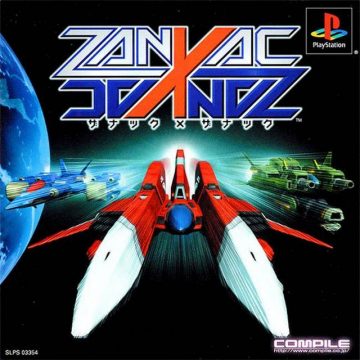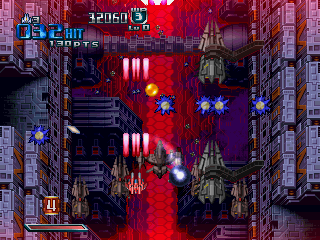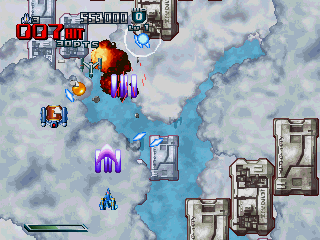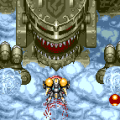Compile almost completely stopped developing shoot-em-ups after 1993’s Sylphia, as some of the staff had since departed to form Raizing, and the genre’s popularity was waning in both the wake of 2D fighting and the wave of 3D consoles. Through most of the remainder of the ‘90s, the company focused on their Puyo Puyo series, which kept them above water for quite awhile, albeit with diminishing returns. Their swan song, both as their shooter output and the company as a whole, was Zanac x Zanac, released for the PlayStation in Japan in 2001.
Zanac x Zanac technically consists of two games: a port of the original Zanac, and a brand new game called Zanac Neo. The new game not only commemorates the 15th anniversary of the original Zanac but it also returns to the series’ roots. The story is sparse, and there are three pilots – Hokuto Yuuki, Noa Clonebit and Myctness Ikstess – although they barely show up in the game, only as shadows during loading screens and at the end credits.
Although most of the Aleste games and their spinoffs shared commonalities, there was a lot of experimentation both from a visual and game design standpoint – for example, Super Aleste has some obvious similarities to Zanac but it plays much differently. This release calls back to the original 1986 game – the visual design is similar, it features the return of the AI generation system, and the weapon equipment and power-up systems are the same.
All of these aspects have been improved to make it a little more modern. There are a wider variety of difficulty levels and the AI isn’t nearly as brutal as it used to be, offering a more palatable, less overwhelming curve. The levels are still kinda long but there’s greater visual variations so it’s less repetitive. There are four ships (three regularly selectable plus one hidden one) each with their own unique subweapon arsenal. Though many weapons are similar (most of them have a variation on the “orb that spins around your ship” weapon that’s been around since Aleste) they all technically behave slightly differently, making for a total of 32 weapons, the largest of any Compile shooter. Their usage is unlimited now too, and even though they get reset down to the lowest level when you die, there are tricks to immediately bring it back up to full strength. Familiar friends like the fairy Rio and Randar make appearances, too.
There’s a slightly more in-depth scoring system, with a combo meter that increases as you destroy things and resets if you let an enemy leave the screen. Also new is a special “burst” weapon, which gains power as you either kill enemies or grab power-ups. It fires an explosive beam which can generate score multipliers, depending on how many enemies you kill with it.
As a throwback to the earlier days of the genre, Zanac Neo is fantastic, but compared to other 2D shooters, it does look and feel a little dated. Some of the visual design is decent, like the dark red space fortress in the prologue stage, or the occasional polygonal boss, but otherwise it looks and feels quaint, especially the small sprites. It looks okay, but some of their later 16-bit games like Spriggan are a lot more visually interesting. It would’ve been nice if the game had been developed as a tribute to their wider shooter library, rather than just Zanac. The music is also just okay – outside of a few remixes of the old Zanac theme, most of the music consists of trance and electronica. Overall it’s kind of boring, especially compared to the excellent legacy of Compile’s other games.
In addition to Zanac Neo, there are three variations of the original Zanac, which is faithfully ported over from the Nintendo console version. The “Disk” and “ROM” versions are based on the Famicom Disk System and American cartridge release, which have some minor balancing differences. There’s also a “Special” version which hugely increases the difficulty but also improves your firepower. It’s great to have these included, though it also would’ve been better if they’d also ported the (incredibly rare) MSX and MSX2 versions.
Despite being a loving tribute to the game that brought them such success, Zanac x Zanac was definitely not suited to the marketplace in 2001, and did not perform well. While the PS1 disc is a valuable collector’s item, it was released on the PlayStation Network, and was even released in North America, making it more cheaply and easily obtainable to Compile fans outside of Japan.
After Compile folded the next year in 2002, their staff went in different directions – president Masamitsu Niitani formed Compile Heart, which concentrated on anime-style RPGs; Takayuki “Jemini” Hirono joined Kazuyuki Nakashima at Raizing; and other staff, mostly assorted programmers, artists and musicians, formed Milestone, who created several other shooters including Chaos Field, Radirgy, and Karasu.




